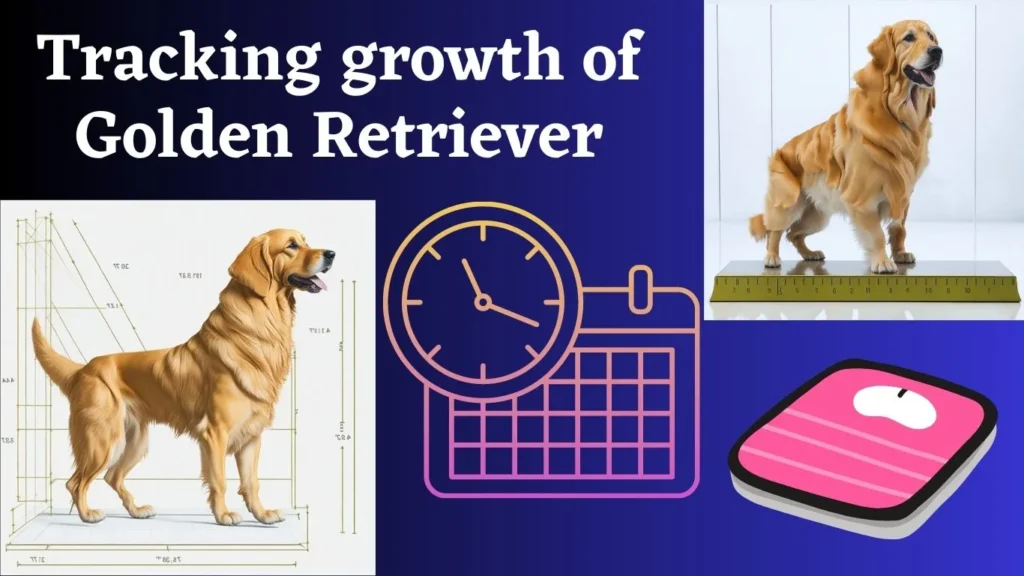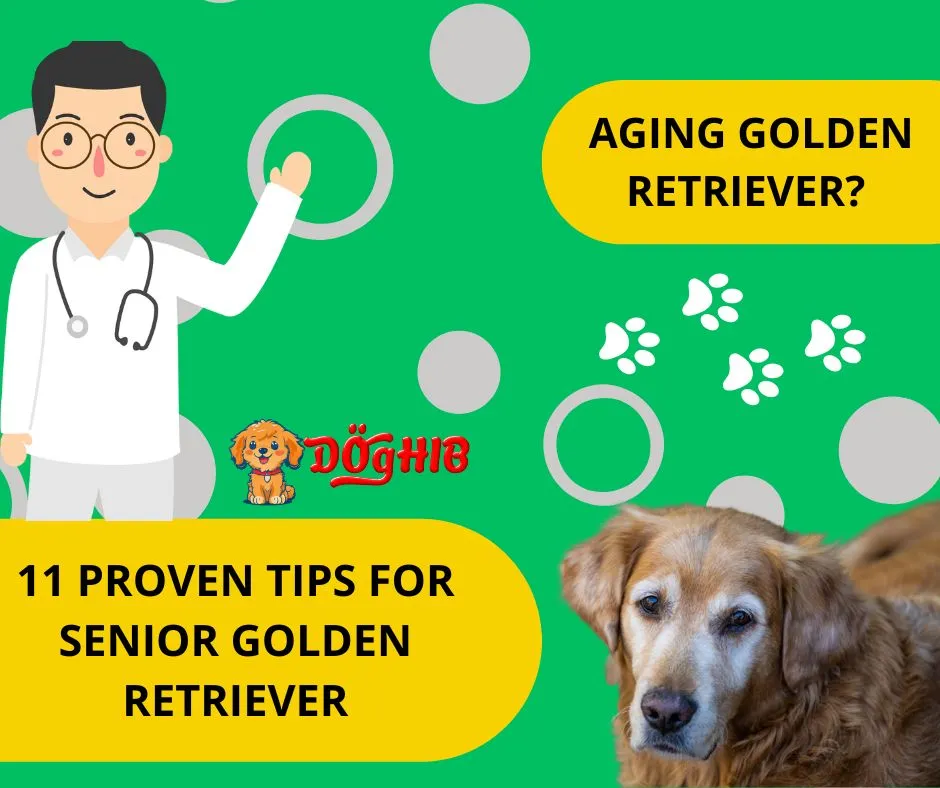Like any other living beings, Golden Retrievers go through various growth stages that significantly impact their development. In this article we will provide you with a comprehensive guide to Golden Retriever growth stages. We’ll dive into key milestones, nutritional needs, feeding guidelines, and a detailed growth chart.
Whether you’re a new owner or have had a Golden Retriever for years, this information will empower you to support your furry companion’s healthy growth and overall well-being.

| 💡 Key Takeaways |
|---|
| Golden Retrievers go through several growth stages: neonatal, transitional, socialization, and juvenile. |
| Golden Retrievers are medium to large-sized dogs, with males weighing 65-75 pounds and females weighing 55-65 pounds on average. |
| Using a Golden Retriever growth chart helps track their progress and ensure healthy development. |
| Feeding guidelines for Golden Retrievers include a well-balanced diet rich in protein, healthy fats, vitamins, and minerals. |
| Transitioning from puppy food to adult food should be done gradually over a week or two. Consult a veterinarian for personalized advice. |
Table of Contents
Golden Retriever Growth Stages

A. Puppy Developmental Stages
A Golden Retriever puppy goes through several crucial developmental stages, each accompanied by significant milestones.
These stages include the neonatal period (0-2 weeks), transitional period (2-4 weeks), socialization period (4-12 weeks), and juvenile period (3-6 months). During these stages, puppies experience rapid physical and cognitive growth, including the development of their senses, social skills, and exploration abilities.
Related: Golden Retriever Puppy Behavior Stages
Golden Retriever puppy growth shows its nutritional needs. During the early weeks, it relies on its mother’s milk for essential nutrients. As it transitions to solid food, a high-quality puppy food specifically formulated for large breeds is recommended. This diet contains balanced proportions of proteins, fats, and carbohydrates to support healthy growth and bone development.
B. Adolescence Growth Stage
During the adolescent stage, your Golden Retriever will experience significant physical changes. They’ll go through a growth spurt, where their bones and muscles develop rapidly. Their puppy features will start to give way to a more adult appearance. This stage typically occurs between 6 months and 18 months.
Here’s what you can expect during this period:
- Male Golden Retriever weigh between 45-75 pounds and reach a height of around 21-24 inches.
- Female Golden Retriever typically weigh between 40-65 pounds and have a height of approximately 20-23 inches.
As your Golden Retriever transitions into adolescence, it’s important to adjust their feeding regimen accordingly. Switching to a high-quality adult dog food is recommended, formulated to meet their specific nutritional needs during this stage.
To support your dog’s growth and development, it’s crucial to ensure that their food contains a balanced and adequate amount of protein, vitamins, and minerals.
C. Adult Size and Adult Weight
Golden Retrievers are medium to large-sized dogs. On average, adult sized males stand between 23-24 inches at the shoulder and weigh between 65-75 pounds (29-34 kg).
Females are slightly smaller, measuring around 21.5-23 inches in height and weighing between 55-65 pounds (25-29 kg).
Golden Retriever Growth Chart
Having a dog growth chart for your Golden Retriever allows you to track their progress and ensure they are growing as expected. It helps you monitor their size, weight, and overall development, providing valuable insights into their well-being.
Here’s a comprehensive Golden Retriever weight chart, detailing the weight and height ranges for each age milestone:
| Age (Months) | Male Weight Range (lbs) | Female Weight Range (lbs) | Male Height Range (inches) | Female Height Range (inches) |
|---|---|---|---|---|
| 2 | 12 – 20 | 10 – 18 | 11 – 15 | 10 – 14 |
| 3 | 20 – 30 | 18 – 26 | 15 – 19 | 14 – 18 |
| 4 | 28 – 42 | 25 – 37 | 17 – 22 | 16 – 21 |
| 5 | 33 – 52 | 30 – 45 | 18 – 23 | 17 – 22 |
| 6 | 37 – 61 | 34 – 51 | 19 – 24 | 18 – 23 |
| 7 | 40 – 66 | 36 – 55 | 20 – 25 | 19 – 24 |
| 8 | 43 – 70 | 39 – 59 | 21 – 25.5 | 19.5 – 24.5 |
| 9 | 45 – 74 | 41 – 63 | 21.5 – 26 | 20 – 25 |
| 10 | 47 – 77 | 43 – 66 | 22 – 26.5 | 20.5 – 25.5 |
| 11 | 49 – 80 | 44 – 69 | 22.5 – 27 | 21 – 26 |
| 12 | 51 – 83 | 46 – 72 | 23 – 27.5 | 21.5 – 26.5 |
It’s important to note that these ranges are averages, and individual Golden Retrievers may fall outside these ranges. Monitor your dog’s growth and consult your veterinarian for personalized advice.
Tracking your Golden Retriever’s growth using the chart

To track your dog’s growth, record their weight and height at different ages and compare it with the corresponding ranges on the weight chart.
This will help you ensure they’re within the healthy range. Regularly updating the chart allows you to monitor their progress and address any concerns promptly.
Feeding Guidelines for Golden Retrievers Growth
Golden Retrievers require a well-balanced diet that meets their nutritional needs. A diet rich in high-quality protein, healthy fats, vitamins, and minerals supports their growth and overall health. Consult your veterinarian to determine the best diet plan for your Golden Retriever based on their age, weight, and any specific dietary considerations.

Now, let’s talk about the feeding chart for Golden Retriever puppies during their first year.
Feeding chart for puppies based on weight and age
Please note that the following feeding chart is a general guideline. Individual puppies may have unique dietary needs, and consulting your veterinarian is always recommended.
| Puppy Weight (lbs) | Age (months) | Daily Meals | Puppy Food Amount (cups) |
|---|---|---|---|
| (Up to 2 weeks) | – | Every 2-3 hours | 1-2 tablespoons of puppy formula |
| (2-8 weeks) | – | 4-6 | 1/4-1/2 |
| 5-10 | 2-3 | 3 | 1-1.5 |
| 10-25 | 3-6 | 2-3 | 1.5-2.5 |
| 25-45 | 6-9 | 2 | 2.5-3.5 |
| 45-70 | 9-12 | 2 | 3.5-4.5 |
Please remember to choose high-quality puppy food specifically formulated for Golden Retrievers. Monitor your puppy’s weight and adjust the portions accordingly to maintain a healthy growth rate. Additionally, always provide fresh water and consider dividing the meals to prevent overeating or digestive issues.
Transitioning from puppy food to adult food
As your Golden Retriever reaches adulthood, usually around 12 months of age, you can gradually transition them from puppy food to adult dog food. Start by mixing a small amount of the adult food with the remaining puppy food, gradually increasing the proportion of adult dog food over a week or two. This gradual transition helps prevent any digestive upsets.
Special considerations for English Cream Golden Retrievers
English Cream Golden Retrievers, also known as White Golden Retrievers, share similar growth patterns and nutritional requirements as their Golden Retriever counterparts. However, due to their lighter coat color, they may be more susceptible to certain health conditions. Consult your veterinarian for any specific recommendations or considerations for English Cream Golden Retrievers.
Managing Golden Retriever Weight
Maintaining a healthy weight is crucial for your Golden Retriever’s overall well-being. The ideal weight range varies based on the individual dog’s size, structure, and overall health. Consult your veterinarian to determine the appropriate weight range for your Golden Retriever and monitor their weight regularly to ensure they stay within that range.

Factors influencing weight variations and how to address them
Several factors can contribute to weight variations in Golden Retrievers, including diet, exercise, metabolism, and genetics. If your Golden Retriever is underweight or overweight, consult your veterinarian for guidance. They can assess your dog’s specific needs and provide recommendations on adjusting their diet, exercise routine, and portion sizes to achieve a healthy weight.
Recommended exercise routines for weight management
Regular exercise is essential for maintaining your Golden Retriever’s weight and overall health. Engage them in daily physical activities such as walks, runs, fetch, or swimming. The intensity and duration of exercise may vary based on their age, health, and energy levels. It’s important to strike a balance between providing enough exercise to prevent weight gain and avoiding excessive strain on growing joints.
Signs of obesity or weight-related issues
Obesity can lead to various health problems in Golden Retrievers, including joint issues, heart disease, and diabetes. Watch out for signs of obesity such as excessive weight gain, difficulty breathing, decreased activity levels, and trouble moving. If you suspect your Golden Retriever is overweight or experiencing weight-related issues, consult your veterinarian for proper diagnosis and guidance.
Conclusion
Congratulations, Golden Retriever enthusiasts! You’re now armed with the knowledge to guide your furry friend through their growth stages with confidence and style. Remember, understanding puppy growth, tracking their progress with the growth chart, and providing proper nutrition and care are essential for a healthy and happy Golden Retriever. So, put these tips into action, celebrate every wagging milestone, and cherish the journey of raising a magnificent Golden Retriever companion. Wishing you and your golden puppy a lifetime of joy, laughter, and adventures!
Note: The information provided in this guide is for general knowledge purposes. Always consult with your veterinarian for personalized advice regarding your Golden Retriever’s growth and well-being.



